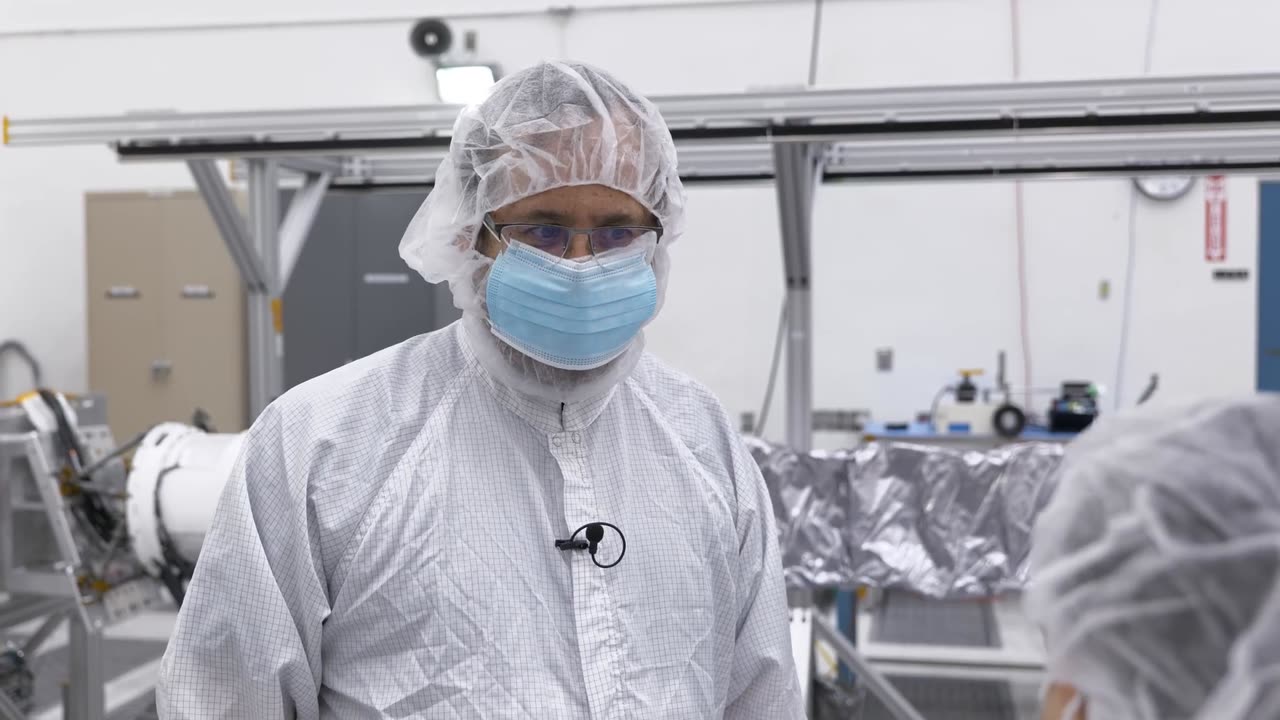Premium Only Content

Spacecraft Makers: Testing Europa Clipper’s Magnetometer
#spacecraft #spacecraftmakers #testingeuropaclippers #europaclippers #magnetometer #nasa #nasaspacemission #nasa2030 #spacecraft2030 #jetpropulsion #launch #jupiter #jupiterexploration #jupiterjourney #spaceexploration #wc1 #wolfchamp
Spacecraft Makers: Testing Europa Clipper’s Magnetometer
Join team members from NASA’s Europa Clipper mission in a clean room at NASA’s Jet Propulsion Laboratory to learn about testing of the spacecraft’s magnetometer, which will help scientists answer the question, “Does Europa have an ocean?”
The magnetometer is made up of a long, 28-foot (6.5-meter) boom and three fluxgate sensors, which are compressed in a canister on the side of the spacecraft until the boom is deployed after launch. The electronics for the instrument are contained in the vault of the spacecraft, along with electronics for the other science instruments.
Spacecraft Makers is a video series that takes audiences behind the scenes to learn more about how space missions, like Europa Clipper, come together. Europa Clipper will explore this icy moon of Jupiter to see if there are conditions suitable for life. Scientists have evidence that a global ocean lies under the moon’s surface, and the mission aims to confirm the existence of the ocean.
The spacecraft needs to be hardy enough to survive a 1.6-billion-mile, six-year journey to Jupiter – and sophisticated enough to perform a detailed science investigation of Europa once it arrives at the Jupiter system in 2030.
Europa Clipper is expected to launch in October 2024 from Kennedy Space Center in Florida.
Spacecraft Makers: Testing Europa Clipper’s Magnetometer
Join team members from NASA’s Europa Clipper mission in a clean room at NASA’s Jet Propulsion Laboratory to learn about testing of the spacecraft’s magnetometer, which will help scientists answer the question, “Does Europa have an ocean?”
The magnetometer is made up of a long, 28-foot (6.5-meter) boom and three fluxgate sensors, which are compressed in a canister on the side of the spacecraft until the boom is deployed after launch. The electronics for the instrument are contained in the vault of the spacecraft, along with electronics for the other science instruments.
Spacecraft Makers is a video series that takes audiences behind the scenes to learn more about how space missions, like Europa Clipper, come together. Europa Clipper will explore this icy moon of Jupiter to see if there are conditions suitable for life. Scientists have evidence that a global ocean lies under the moon’s surface, and the mission aims to confirm the existence of the ocean.
The spacecraft needs to be hardy enough to survive a 1.6-billion-mile, six-year journey to Jupiter – and sophisticated enough to perform a detailed science investigation of Europa once it arrives at the Jupiter system in 2030.
Europa Clipper is expected to launch in October 2024 from Kennedy Space Center in Florida.
Spacecraft Makers: Testing Europa Clipper’s Magnetometer
Join team members from NASA’s Europa Clipper mission in a clean room at NASA’s Jet Propulsion Laboratory to learn about testing of the spacecraft’s magnetometer, which will help scientists answer the question, “Does Europa have an ocean?”
The magnetometer is made up of a long, 28-foot (6.5-meter) boom and three fluxgate sensors, which are compressed in a canister on the side of the spacecraft until the boom is deployed after launch. The electronics for the instrument are contained in the vault of the spacecraft, along with electronics for the other science instruments.
Spacecraft Makers is a video series that takes audiences behind the scenes to learn more about how space missions, like Europa Clipper, come together. Europa Clipper will explore this icy moon of Jupiter to see if there are conditions suitable for life. Scientists have evidence that a global ocean lies under the moon’s surface, and the mission aims to confirm the existence of the ocean.
The spacecraft needs to be hardy enough to survive a 1.6-billion-mile, six-year journey to Jupiter – and sophisticated enough to perform a detailed science investigation of Europa once it arrives at the Jupiter system in 2030.
Europa Clipper is expected to launch in October 2024 from Kennedy Space Center in Florida.
Spacecraft Makers: Testing Europa Clipper’s Magnetometer
Join team members from NASA’s Europa Clipper mission in a clean room at NASA’s Jet Propulsion Laboratory to learn about testing of the spacecraft’s magnetometer, which will help scientists answer the question, “Does Europa have an ocean?”
The magnetometer is made up of a long, 28-foot (6.5-meter) boom and three fluxgate sensors, which are compressed in a canister on the side of the spacecraft until the boom is deployed after launch. The electronics for the instrument are contained in the vault of the spacecraft, along with electronics for the other science instruments.
Spacecraft Makers is a video series that takes audiences behind the scenes to learn more about how space missions, like Europa Clipper, come together. Europa Clipper will explore this icy moon of Jupiter to see if there are conditions suitable for life. Scientists have evidence that a global ocean lies under the moon’s surface, and the mission aims to confirm the existence of the ocean.
The spacecraft needs to be hardy enough to survive a 1.6-billion-mile, six-year journey to Jupiter – and sophisticated enough to perform a detailed science investigation of Europa once it arrives at the Jupiter system in 2030.
Europa Clipper is expected to launch in October 2024 from Kennedy Space Center in Florida.
Spacecraft Makers: Testing Europa Clipper’s Magnetometer
Join team members from NASA’s Europa Clipper mission in a clean room at NASA’s Jet Propulsion Laboratory to learn about testing of the spacecraft’s magnetometer, which will help scientists answer the question, “Does Europa have an ocean?”
The magnetometer is made up of a long, 28-foot (6.5-meter) boom and three fluxgate sensors, which are compressed in a canister on the side of the spacecraft until the boom is deployed after launch. The electronics for the instrument are contained in the vault of the spacecraft, along with electronics for the other science instruments.
Spacecraft Makers is a video series that takes audiences behind the scenes to learn more about how space missions, like Europa Clipper, come together. Europa Clipper will explore this icy moon of Jupiter to see if there are conditions suitable for life. Scientists have evidence that a global ocean lies under the moon’s surface, and the mission aims to confirm the existence of the ocean.
The spacecraft needs to be hardy enough to survive a 1.6-billion-mile, six-year journey to Jupiter – and sophisticated enough to perform a detailed science investigation of Europa once it arrives at the Jupiter system in 2030.
Europa Clipper is expected to launch in October 2024 from Kennedy Space Center in Florida.
-
 LIVE
LIVE
Barry Cunningham
2 hours agoIT'S MOVIE NIGHT WITH BARRY!
4,152 watching -
 31:05
31:05
The Why Files
2 days agoPeru's Most Terrifying Mystery | The Face Peelers
20.1K40 -
 1:32
1:32
Gaming on Rumble
10 hours agoWhat is the Rumble Creator Program?!?! | Lvl UP
12.4K4 -
 LIVE
LIVE
Flyover Conservatives
22 hours ago9/11 on Steroids: What’s Coming This Fall? - Bo Polny | FOC Show
794 watching -
 1:01:28
1:01:28
Precision Rifle Network
7 hours agoS4E27 Guns & Grub - Let's Talk About Gas Guns
5.65K1 -
 59:29
59:29
The Charlie Kirk Show
3 hours agoTHOUGHTCRIME Ep. 96 — The Great Flag Burning Debate
32.2K23 -
 57:56
57:56
The Mel K Show
3 hours agoMel K & General Mike Flynn | Betrayal of a Nation: Soros’ NATO World Order | 8-28-25
20.2K21 -

Joker Effect
2 hours agoInterviewing BEN JAMMINS! A personality with over 1 BILLION gif views. Let's give him a warm welcome
9.35K -
 11:37
11:37
Robbi On The Record
8 hours agoThe Devil is in the Branding..
11.6K8 -
 1:26:44
1:26:44
Savanah Hernandez
4 hours agoWhy Gen-Z Is So Radicalized Against Immigration
10.8K5